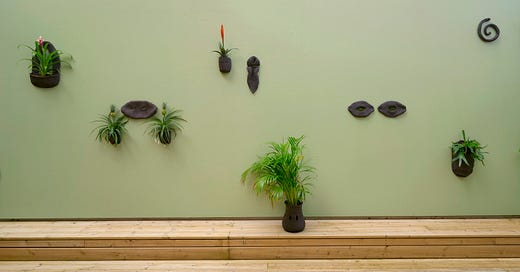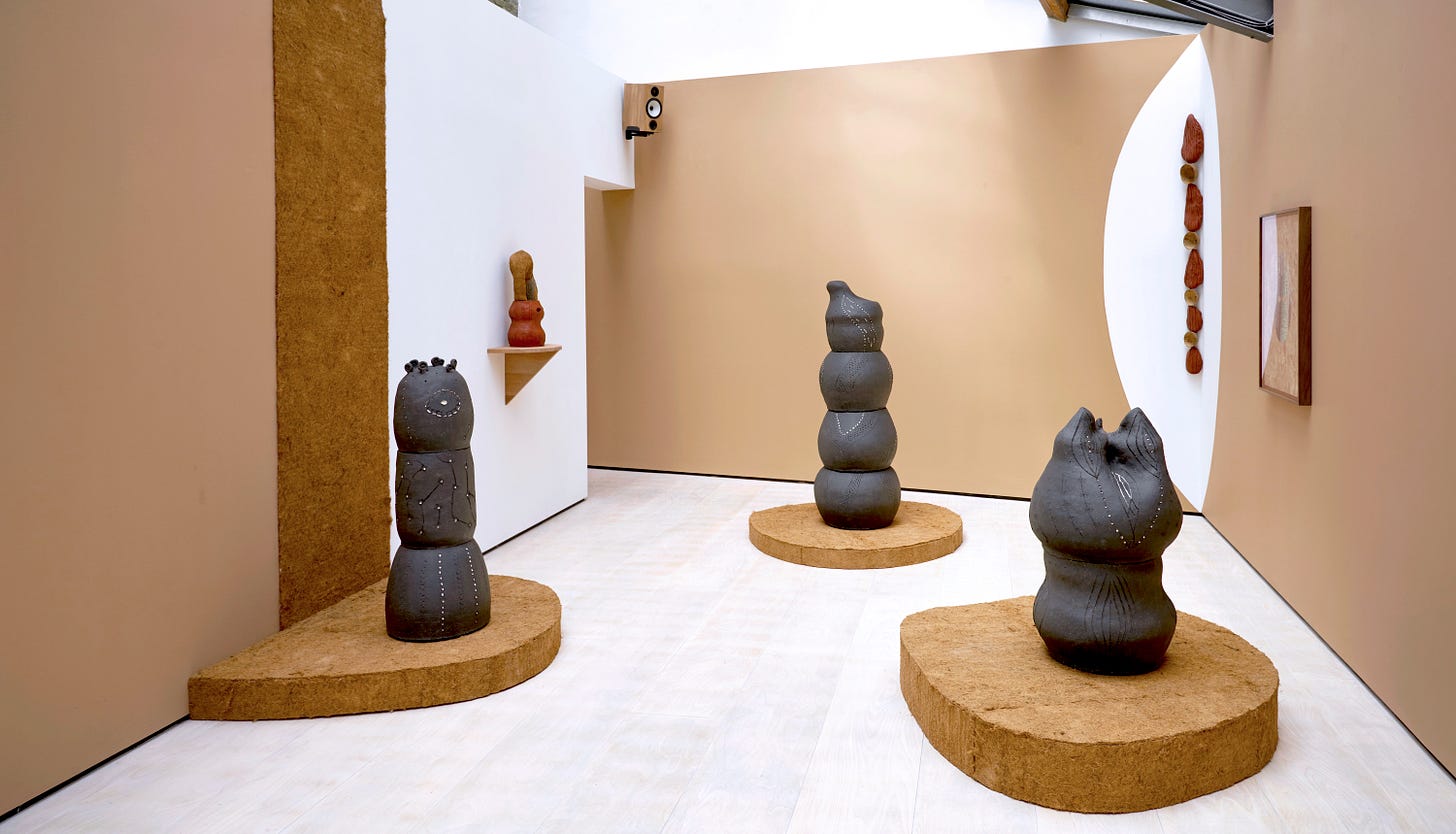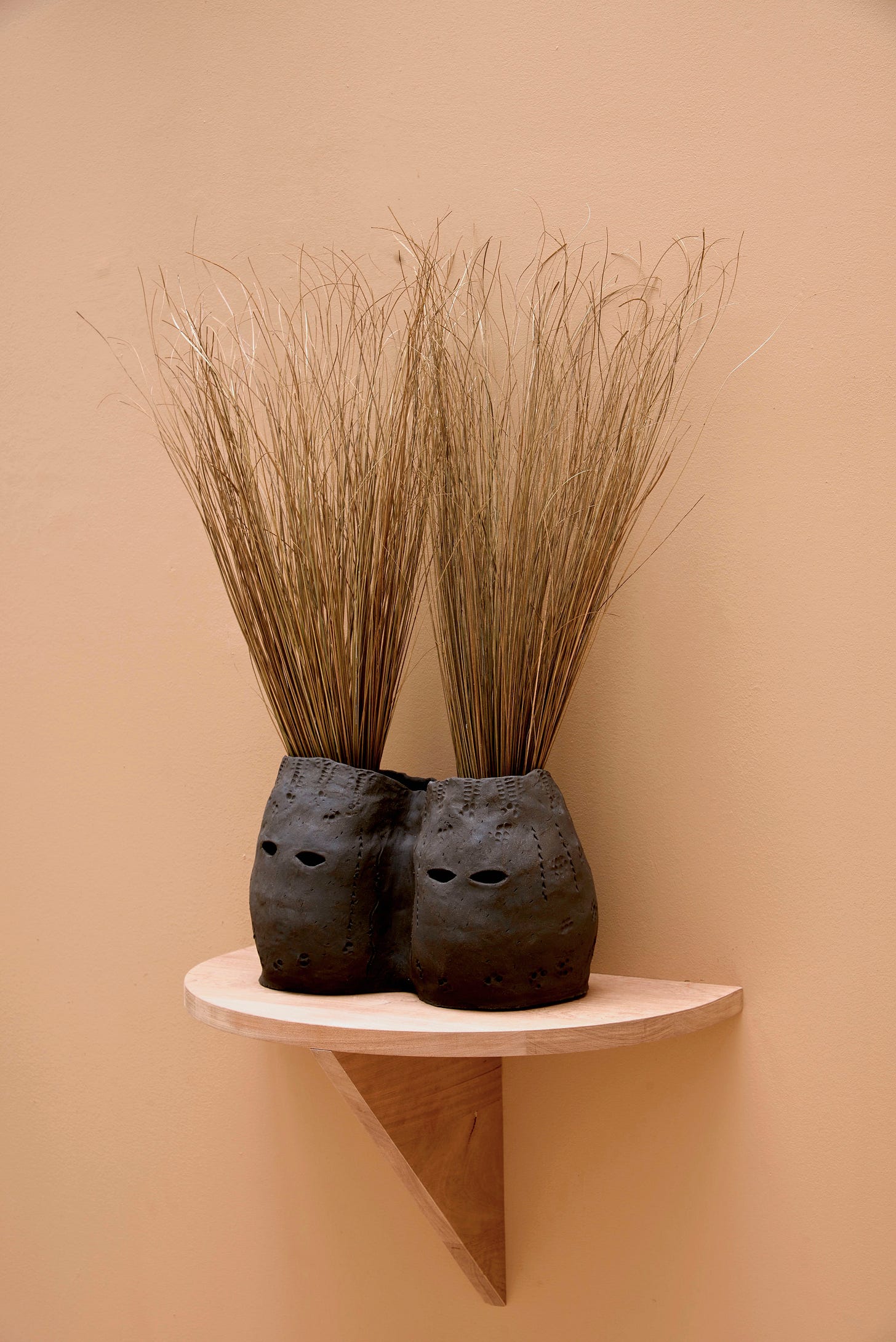Plants and people
Lucia Pizzani's rites and refuges | Spotlight on Iman Datoo | In the mycelium...
Lucia Pizzani’s rites and refuges
Working across sculpture, installation, and collage, Lucia Pizzani’s creative world weaves an intimate dance between people, earth, and plants. Her current solo show at Cecilia Brunson Projects in London draws together an extensive ongoing body of research into interspecies migrations, ancient rituals, and seed dispersal. Totemic clay sculptures imprinted with seedpods float on coconut-husk rafts while collaged vegetal deities look down from the walls. Outside, tropical plants emerge from face-like vessels, sprouting into hybridity.
“I was trying to humanise the vegetal world,” says Pizzani, who has a background in conservation biology and Venezuela’s environmental movement. “We often have a much closer relationship with animals than with plants. In order to see change and movement in plants, the observation period has to be very long. It’s only recently that in Western cultures we are beginning to understand vegetal intelligence.”
The exhibition includes a series of collaged images of hybrid deities and vegetal forms that recall ritual objects. These collages are made with Amate paper, hand-crafted from tree bark by Indigenous craftspeople. Pizzani was drawn to this product because “it is a paper made with tree bark, mostly from Ficus species, used by Mesoamerican cultures in their first codices. The production of this paper was banned by Spanish colonisers, because of course paper is a way of distributing information. So it was a form of resistance for them to keep producing the paper, which can still be bought in the markets there. This is one of the ways to relate and represent the spirits of trees.”
Pizzani explains that the body of work presented in Rites, Seeds and Refuges is rooted in a project she undertook in Mexico at Casa Wabi (Oaxaca) in 2021, when she first began her characteristic process of printing with plants. “It also links to earlier work I made, such as my degree show in which I made imprints of my body in the walls of a space,” she goes on. “I was looking at the work of Ana Mendieta and the idea of the trace, and what she was doing in the environment, trying to connect with the earth as a migrant or exile.”
When she began working with corn in Mexico City while doing a residency at Fundación Marso in 2019, she also learned about “a Central American deity related to the corn harvest, where the priest would wear the skin of a defeated warrior. I was interested in this idea of two skins on one body, but I realised everything came back to the corn, which is so important to the Americas. It’s our bread, and it’s related to a lot of creation myths across American cultures.”
These multiplicitous ideas coalesced when she began bringing corn back to the UK. “The sculptures took on a new element, bringing together two territories: English clay imprinted with Central American corn.” In Pizzani’s hands, the corn becomes a signifier of migration, telling an entangled story of both humans and plants. The resulting totemic works are layered with the places and species that make up identity and ancestry.
The imprint of the corn has a quality that recalls snakeskin, scales, or woven armour, suggesting parallels between the plant, animal, and human spheres. “I began to collect images of pangolins and other animals that have protective armour or spines,” Pizzani says. “Then when Covid happened, the pangolin was identified as a possible carrier species for the disease. I began trying to reverse the dominant discourse: instead of saying that this disease came from animals or from nature, we should say that the disease comes from humans interfering with nature’s cycles. The pandemic came about from the environmental crisis.”
“I discovered that the forest usually absorbs viruses,” she continues. Due to the diversity of species found in the forest, viruses are dispersed throughout the environment, reducing their impact. However, deforestation and the resulting loss of biodiversity both concentrate the spread of diseases and make it more likely that humans will come into contact with contaminants. “I’m more convinced than ever that nature is a refuge,” says Pizzani.
Change, she suggests, can only come about through respect, empathy, and recognition of the sacred. “In the spirituality of things, you respect things for what they are. A tree can be a mother tree, making sure that other trees are healthy. And that makes the forest a mirror for us; if the forest is healthy, we can be healthy.”
Follow @luciapizzani | Website
Lucia Pizzani: Rites, Seeds and Refuge continues at Cecilia Brunson Projects, London, until 9 August 2024
All images courtesy of Cecilia Brunson Projects. Photographs by Andy Keate.
Spotlight on… Iman Datoo
Soil-brain, Gut-brain, Installation view, Against Apartheid at KARST Gallery, Sep-Dec 2023, Photo: Luke Frost
Movement and belonging serve as central themes in Iman Datoo’s art and storytelling practice. Her work is time-based and often reflects on structures of thought and language within botany, ecology, and ethnobotany, exploring the interrelations between humans and plants. Challenging binary notions, Iman imagines dynamic relations beyond hegemonic systems, creating routes into imaginary worlds from which new dialogues about a collective future might emerge. These worlds often take the form of installations, films, workshops, or participatory performances. In recent collaborations with the University of Exeter, the Eden Project in Cornwall, and Radical Ecology at KARST, the artist has focused on soil communities, intrinsically linked to humans through the plants that we cultivate and consume, and in their movement and behaviour across borders.
Notable recent work includes Soil-Brain, Gut-Brain (2023), an audio and tactile installation, exploring the intimate entanglements of soils and worms through the lens of eating, digesting, and nourishment. Currently Iman is exhibiting new work - a gouache map and audio guide - in Invasion Ecology, a Land Art exhibition in Dartmoor, and has been commissioned by the University of Exeter to create a film on soil health in Cornwall’s mining areas.
Follow @imandatoo | Website
In the mycelium…
Invasion Ecology, Southcombe Barn, Dartmoor | 1 June - 10 August 2024
Cradle, 28 Shacklewell Lane, London | 20 June – 14 July 2024 | Curated by Anna Souter
Miriam de Burca: Noblesse Oblige, Cristea Roberts, London | 21 June - 27 July 2024
Garden at the End of Time, Tin Sheds Gallery, Sydney, Australia | 6 June - 19 July 2024
This newsletter is free for now…
…but in the future I hope to turn on paid subscriptions to make it sustainable for me. In the meantime, I’d love to hear any feedback and whether you might be happy to upgrade to a paid tier in the future!









